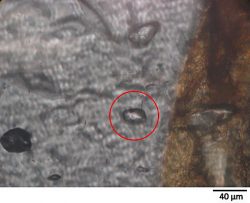Geobarometry from Raman Micro-spectrometry of Quartz Inclusions in Garnet: An Evaluation
Casey Corbin

Laser Raman microspectrometry is a promising technique for determining metamorphic pressures using quartz inclusions in garnet. My study focused on determining the accuracy and precision of Raman spectrometry as a geobarometer by analyzing samples from localities that have experienced differing metamorphic conditions, in order to establish how this technique may be applied to other metamorphic systems in the future.
Laser Raman microspectrometry was applied to metamorphic quartz inclusions in garnet from three localities, the Picuris Mountains, New Mexico (550 oC, 0.45 GPa); Passo del Sole, central Swiss Alps (560 ± 30 oC, 0.85 ± 0.05 GPa); and the aureole of the Makhavinekh Lake Pluton, Labrador (825 oC, 0.8-1.0 GPa), in order to determine the precision and accuracy of Raman microspectrometry as a geobarometer and its applicability over a wide range of metamorphic conditions. ÊThe three main Raman peaks of a quartz inclusion, which is completely enclosed in garnet, shift relative to a quartz standard when a residual pressure on the inclusion is present. ÊThis residual pressure is a result of the changes in volume of both the quartz inclusion and the garnet during the exhumation and cooling of the metamorphic rock. ÊThis residual pressure can be quantified using a calibration of its relationship to the peak shift and then, using an elastic strain model, the entrapment pressure can be calculated.
Each of the localities that were analyzed in this study has metamorphic conditions that are well-constrained by conventional barometry and thermometry. ÊThe data collected in this study were compared to these previously determined values. ÊAdditionally, a single quartz inclusion was measured repeatedly to determine the internal precision of this technique.
A set of 17 measurements on a single inclusion produced entrapment pressures for which the standard deviation is 0.20 GPa, indicating limited precision for this technique. ÊNine quartz inclusions were measured from the the Picuris Mountains and have calculated entrapment pressures that range from 0.06 to 0.80 GPa. ÊEight quartz inclusions were measured from Passo del Sole and have calculated entrapment pressures that range from 0.55 to 1.06 GPa. Eleven quartz inclusions were measured from the aureole of the Makhavinekh Lake Pluton and have calculated entrapment pressures that range from -2.39 to 0.75 GPa. Ê
The spread of values above and below the expected entrapment pressures for the Picuris Mountains and Passo del SoleÊlocalities may be due to factors that are unaccounted for by this technique, in addition to the quantified imprecision of the technique of 0.20 GPa. ÊSuch deviations from the expected values for entrapment pressure might be due to partial release of compressional stress that occurred during cutting of the thin section, or to inclusions whose shape is different from the spherical shape assumed by the elastic-strain model. In the rocks from the aureole of the Makhavinekh Lake Pluton, the highly scattered distribution and negative values can be interpreted as evidence that some quartz inclusions from this locality were entrapped by garnet as a-quartz. ÊThis finding identifies a limitation to the applicability of this technique: it appears to be inapplicable to rocks that experienced metamorphism at or above the a-b-quartz transition.
|
|

